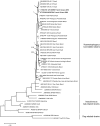Bioecological Drivers of Rabies Virus Circulation in a Neotropical Bat Community
- PMID: 26808820
- PMCID: PMC4726525
- DOI: 10.1371/journal.pntd.0004378
Bioecological Drivers of Rabies Virus Circulation in a Neotropical Bat Community
Abstract
Introduction: In addition to the commonly accepted importance of the vampire bat in the maintenance and transmission of the rabies virus (RABV) in South America, RABV infection of other species is widely evidenced, challenging their role in the viral cycle.
Methodology / principles findings: To identify the bioecological drivers of RABV circulation in neotropical bat communities, we conducted a molecular and serological survey on almost 1,000 bats from 30 species, and a 4-year longitudinal survey in two colonies of vampire bats in French Guiana. RABV was molecularly detected in a common vampire and in a frugivorous bat. The sequences corresponded to haematophagous bat-related strains and were close to viruses circulating in the Brazilian Amazon region. Species' seroprevalence ranged from 0 to 20%, and the risk of seropositivity was higher in bats with a haematophagous diet, living in monospecific colonies and in dense forests. The longitudinal survey showed substantial temporal fluctuations, with individual waves of seroconversions and waning immunity. The high prevalences observed in bat communities, in most habitats and in species that do not share the same microhabitats and bioecological patterns, the temporal variations, and a rather short period of detectable antibodies as observed in recaptured vampires suggest (i) frequent exposure of animals, (ii) an ability of the infected host to control and eliminate the virus, (iii) more relaxed modes of exposure between bats than the commonly assumed infection via direct contact with saliva of infected animals, all of which should be further investigated.
Conclusions / significance: We hypothesize that RABV circulation in French Guiana is mainly maintained in the pristine forest habitats that may provide sufficient food resources to allow vampire bats, the main prevalent species, to survive and RABV to be propagated. However, on the forest edge and in disturbed areas, human activities may induce more insidious effects such as defaunation. One of the ecological consequences is the disappearance of resources for tertiary or secondary consumers. Populations of vampires may then shift to alternative resources such as cattle, domestic animals and humans. Therefore, a good forest status, allowing both a dilution effect in highly rich bat communities and the maintenance of large populations of medium-sized and large mammals used as prey by vampires, should prevent their migration to anthropized areas.
Conflict of interest statement
The authors have declared that no competing interests exist.
Figures




References
-
- Barbosa TF, Medeiros DB, Travassos Da Rosa ES, Casseb LM, Medeiros M, Pereira A de S, et al. Molecular epidemiology of rabies virus isolated from different sources during a bat-transmitted human outbreak occurring in Augusto Correa municipality, Brazilian Amazon. Virology. 2008;370: 228–236. - PubMed
-
- Schneider MC, Romijn PC, Uieda W, Tamayo H, da Silva DF, Belotto A, et al. Rabies transmitted by vampire bats to humans: an emerging zoonotic disease in Latin America? Rev Panam Salud Publica. 2009;25: 260–269. - PubMed
Publication types
MeSH terms
Substances
LinkOut - more resources
Full Text Sources
Other Literature Sources

